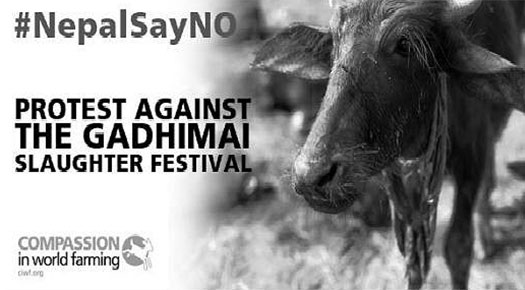
The largest animal sacrifice in the world took off on November 29 in southern Nepal, during which an estimated 200,000 animals, including pigeons, chickens, goats, pigs and buffaloes were slaughtered as part of a religious tradition. The two-day festival, known as Gadhimai Mela, takes place every five years at Gadhimai Temple. The temple, situated 100 miles south of Kathmandu, encourages the killing of thousands of animals in the name of the Hindu goddess of power, as devotees believe the ritual will bring them good luck.
In 2009, an estimated 350,000 animals were killed and approximately, 500,000 animals were supposed to be killed this year, despite animal rights activists campaigning extensively for the festival to be banned.
“The sights and sounds are unimaginable,” wrote Jayasimha Nuggehalli, director of the Indian branch of the Humane Society International. “Pools of blood, animals bellowing in pain and panic, wide-eyed children looking on, devotees covered in animal blood, and some people even drinking blood from the headless but still warm carcasses.”



Millions of Hindus from Nepal and India are known to take part in the festival that reveres Goddess Gadhimai, a deity who is believed to bless her devotees with power and luck. Reportedly, the ritual begins before sunrise on the fields outside Gadhimai Temple, where the head priest trickles his own blood combined with that of some animal he wishes to slaughter.
In the previous years, almost 70 percent of all animals being slaughtered in Nepal came in from India but that figure has dropped ever since India’s Supreme Court criminalized the carrying of animals across borders into Nepal, especially during Gadhimai Mela.
“This year, many devotees were unable to cross the border with animals for sacrifice because of the Indian court order,” said Moti Lal Kasuhawa, secretary of the festival organizing committee. “As a result, we saw a considerable decrease in the number of sacrifices this year.”



The festival is partially funded by the government of Nepal, as it draws in a fair number of tourists, thus helping the state generate a lot of revenue. During this time, thousands of animals are corralled into holding pens in the middle of a large field, before having their heads chopped off or throats slit open.
Shristi Singh Shrestha, an animal rights activist with Animal Welfare Network Nepal, said she felt “defeated” because her group was unsuccessful in stopping the slaughter completely but the number of livestock killed was definitely lower.
“The positive thing is that the number of animals killed has come down … we hope there will be no killing of any animal at the next festival,” she said.
Yet, on Friday morning, thousands of sword-wielding devotees started slaughtering animals, ignoring appeals from animal rights activists who have been wanting to end this heinous ritual.
“It is very festive here, everyone is excited,” said Mangal Chaudhary, the head priest at the slaughter site near a temple devoted to Gadhimai.



While activists from across the world have sent petitions to Nepal’s president to have this cruel ritual banned, the festival continues to attract more than two million Hindus every five years. The Gadhimai Mela originated approximately 260 years ago. Reportedly, after buffaloes are slaughtered, their heads are dumped in a freshly dug pit in the same field and their hides are auctioned off to the highest bidding contractor thereafter.
Joanna Lumley and Brigitte Bardot were among the few public figures that opposed the festival and participated in a protest led by the nonprofit group Compassion in World Farming.
At a rally outside the Nepalese embassy, Lumley said, “I love Nepal – both the land and its people. The Gadhimai animal sacrifice festival entails horrendous animal suffering and is a complete anomaly in this wonderful country.”
http://www.independent.co.uk/incoming/article9892634.ece/alternates/w460...
Many Hindus have argued that the ritual of sacrificing animals at Gadhimai Mela violates the religion’s core beliefs.
Surya Upadhya, chairman of the Nepalese Hindu Forum in the UK, said, “The Nepalese Hindu Forum in the UK completely opposes animal sacrifice as Hinduism does not sanction the killing of living beings. There should not be any place for this inhumane, barbaric sacrifice of innocent animals in the name of any religion.”
The gory images of the festival led to widespread outrage across social media including Twitter, where a huge number of people urged for Gadhimai Mela to be called off, before the next ritual takes place in 2019.
Stop the massacre #GadhimaiFestival #Gadhimai pic.twitter.com/xoO1seSCWo
— Vikram -[V]-rainboy! (@eatit007) November 29, 2014
Never quite understood how killing a speechless, harmless animal in the greed for 'good luck' can be called a 'sacrifice'. #GadhimaiFestival
— Himala Joshi (@Himala) November 29, 2014
Sadly, #GadhimaiFestival is not the only mass slaughter of animals. Around the world, 3,000 animals are killed every second -- for "food."
— Mark Hawthorne Ⓥ (@markhawthorne) November 29, 2014
Centuries old tradition should be discontinued just because some celebs are outraging post foreign media reports on #Gadhimai Wah!
— Alok Bhatt (@alok_bhatt) November 29, 2014
Different cultures may not understand each other’s customs, but all humans comprehend cruelty. Time to ban #Gadhimai pic.twitter.com/Gh4dxWKK3a
— Biek (@burbie72) November 26, 2014
Partito EcoAnimalista, an Italian animal rights group, described Gadhimai as unparalleled religious madness, saying the animals are refused food and water for several days before being slaughtered, so they gradually grow docile and weak and are easier to kill. PETA too, launched a petition, demanding the horrifying display of brutality be stopped immediately.
Its letter read, “The frenzied slaughter of hundreds of thousands of goats, chickens, buffalo and other animals only tarnishes Nepal's international reputation. Numerous animals, already weakened by their long journeys, die from exhaustion, starvation or dehydration before the massacre begins.”
Photo Credits: Cloudfront & Business Insider
